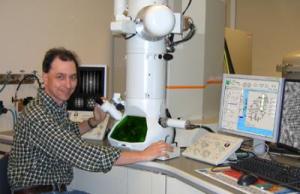Aug 31 2010
About 12,900 years ago, a sudden cold snap interrupted the gradual warming that had followed the last Ice Age.
The cold lasted for the 1,300-year interval known as the Younger Dryas (YD) before the climate began to warm again.
In North America, large animals known as megafauna, such as mammoths, mastodons, saber-tooth tigers and giant short-faced bears, became extinct. The Paleo-Indian culture known as the Clovis culture for distinctively shaped fluted stone spear points abruptly vanished, eventually replaced by more localized regional cultures.
 Tyrone Daulton is pictured with the transmission electron microscrope he used to search in vain for shock-synthesized nanodiamonds, evidence that a extraterrestrial object such as a meteorite killed off North American megafauna.
Tyrone Daulton is pictured with the transmission electron microscrope he used to search in vain for shock-synthesized nanodiamonds, evidence that a extraterrestrial object such as a meteorite killed off North American megafauna.
What had happened?
One theory is that either a comet airburst or a meteor impact somewhere in North America set off massive environmental changes that killed animals and disrupted human communities.
In sedimentary deposits dating to the beginning of the YD, impact proponents have reported finding carbon spherules containing tiny nano-scale diamonds, which they thought to be created by shock metamorphism or chemical vapor deposition when the impactor struck.
The nanodiamonds included lonsdaleite, an unusal form of diamond that has a hexagonal lattice rather than the usual cubic crystal lattice. Lonsdaleite is particularly interesting because it has been found inside meteorites and at known impact sites.
In the August 30 issue of the Proceedings of the National Academy of Sciences, a team of scientists led by Tyrone Daulton, PhD, a research scientist in the physics department at Washington University in St. Louis, reported that they could find no diamonds in YD boundary layer material.
Daulton and his colleagues, including Nicholas Pinter, PhD, professor of geology at Southern Illinois University In Carbondale and Andrew C. Scott, PhD, professor of applied paleobotany of Royal Holloway University of London, show that the material reported as diamond is instead forms of carbon related to commonplace graphite, the material used for pencils.
"Of all the evidence reported for a YD impact event, the presence of hexagonal diamond in YD boundary sediments represented the strongest evidence suggesting shock processing," Daulton, who is also a member of WUSTL's Center for Materials Innovation, says.
However, a close examination of carbon spherules from the YD boundary using transmission electron microscopy by the Daulton team found no nanodiamonds. Instead, graphene- and graphene/graphane-oxide aggregates were found in all the specimens examined (including carbon spherules dated from before the YD to the present). Importantly, the researchers demonstrated that previous YD studies misidentified graphene/graphane-oxides as hexagonal diamond and likely misidentified graphene as cubic diamond.
The YD impact hypothesis was in trouble already before this latest finding. Many other lines of evidence — including: fullerenes, extraterrestrial forms of helium, purported spikes in radioactivity and iridium, and claims of unique spikes in magnetic meteorite particles — had already been discredited. According to Pinter, "nanodiamonds were the last man standing."
"We should always have a skeptical attitude to new theories and test them thoroughly," Scott says, "and if the evidence goes against them they should be abandoned."
Source: http://www.wustl.edu/